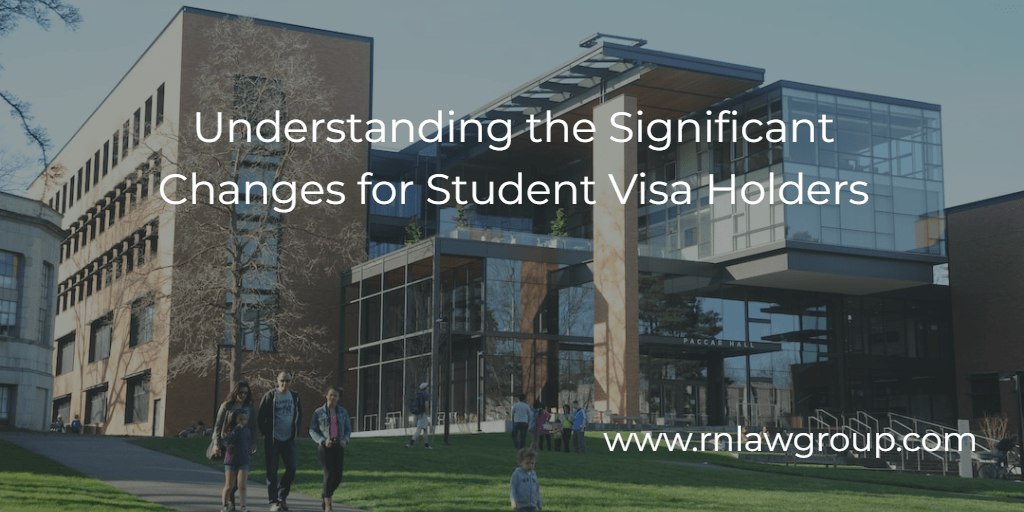
Understanding the Significant Changes for Student Visa Holders
The USCIS Policy Manual is USCIS’ centralized repository for various immigration policies. While it is predominately utilized to “assist immigration officers in rendering decisions,” it is a helpful resource for individuals, companies, and attorneys to seek the latest updates for USCIS policy on various immigration benefits. In December 2023, USCIS provide a major update to the policy manual for F-1 and M-1 international students. Some of the major policy highlights include: clarification of the foreign residency requirement, students being the beneficiary of a permanent labor certification application or immigrant visa petition, STEM OPT especially for employment by a startup company, and more. It is important to note that these changes only apply to USCIS and may not apply the same to Department of State for visa stamping or Customs and Border Protection for entry into the United States.
F-1 and M-1 Student Intent to Depart
One of the most important changes involves the requirement that F-1 and M-1 students must “have a foreign residence, which they have no intent of abandoning.” F-1 and M-1 students are typically required to maintain this foreign residence and intend to return to it upon completion of their program of study and any authorized practical training. This is often a difficult requirement for students to prove as students often times do not have a foreign residence in their own name. In the Policy Manual update, USCIS recognized that “students [often] lack the strong economic and social ties of more established applicants, and they plan longer stays in the United States.” USCIS will look at the foreign residence requirement for students differently than other nonimmigrants. To that tend, if a student has a foreign residence immediately prior to traveling to the United States, even if it is with their parents, they may be considered to be maintaining a residence abroad. However, at the time of applying for F-1 or M-1 status, the student applicant must have a present intent to depart the US as the conclusion of their approved activities. This is a significant codification of policy that will help with younger F-1 and M-1 students that do not own property on their own, but understand that student status requires them to depart the United States at the conclusion of their program.
F-1 and M-1 Students in the Green Card Process
Along the lines of the intent to depart requirement of F-1 and M-1 students is a typical requirement that they maintain non-immigrant intent. That is, generally speaking, F-1 and M-1 students cannot seek lawful permanent residence. The concept behind this is that it would go against the requirement of intent to depart. In the new Policy Manual update, USCIS clarifies that a student may be the beneficiary of an approved or pending labor certification application or an immigrant visa petition (green card application) and can still be able to demonstrate their intent to depart. USCIS clarifies that as long as the student demonstrates that they intend to depart at the end of their studies, they can still qualify for F-1 or M-1 status even if they are in the various stages of the green card process. As noted above, this policy guidance is only applicable to USCIS and students under these circumstances may still face issues at the US consulates or at ports of entry.
STEM OPT Employment by a Startup Company
USCIS has provided guidance on STEM OPT employment when the employing company is a startup company. Generally speaking, there are six regulatory requirements that F-1 students must meet in order to be eligible for a STEM OPT extension:
- The student must have been granted OPT following graduation and must currently be in a valid period of post-completion OPT;
- Earned a bachelor’s degree or higher in a STEM field from an accredited US institution of higher education that is certified by SEVP when the student is submitting their STEM OPT extension application;
- Not be in a multiple employer arrangement, or employed by a sole proprietorship, through a temp agency, through a consulting firm arrangement that provides labor for higher, if such arrangements are not bona-fide employer-employee relationships;
- Note, this is not an outright ban on employment through a consulting firm. This is a requirement that has always been present that the consulting firm must have a valid employer-employee relationship with the F-1 student
- Be employed for no less than 20 hours per week for each qualifying STEM OPT employer;
- Complete the Form I-983 training plan which identifies goals for the training, how these goals will be achieved through the work-based learning opportunity, creates an evaluation process, and describes the supervision; and
Additionally, STEM OPT employers must maintain a bona fide employer-employee relationship, be an E-verify company, have sufficient resources and personnel available to provide appropriate training, and must implement a formal training program to help the academic learning through practical experience.
In the recent Policy Manual update, USCIS clarifies that F-1 students may be employed by a new startup business so long as all other regulatory requirements and the requirements of the Form I-983 are all met. Event as a startup, USCIS will review on a case-by-case basis whether or not the F-1 student will be involved in a bona fide employer-employee relationship. Generally speaking, STEM OPT must be a paid training and STEM OPT students must be receive pay that is commensurate to that provided to similarly situated U.S. employees. In the update, USCIS clarifies that “alternative compensation” may be allowed during a STEM extension so long as a bona fide employer-employee relationship can still be shown. USCIS provides examples such as ownership interest in the company such a stock options, as long as this is commensurate with the compensation provided to other similarly situated U.S. workers.
The December 2023 Policy Manual updates provide critical changes high-skilled immigrants and visa holders should know when navigating F-1/M-1 status and work authorization.
Conclusion
For skilled graduates on OPT/STEM OPT, guidance around startup jobs and alternative compensation like stock options, if commensurate to US workers, enables more career-building with emerging tech employers and emerging technologies. Additionally, even those well into the green card process can now qualify for student status, as long as the applicant is able to clearly show the intent to depart after program completion. This helps smooth the bridge from F-1/STEM OPT to permanent residence for employees indispensable to sponsors.
While State Department and CBP policies still require caution, the USCIS Policy Manual shifts reflect an encouraging direction to retain high-skilled talent post-graduation. For high-skilled students and degree holders, engage qualified immigration lawyers to incorporate these updates into your career and immigration strategy.
Reddy Neumann Brown PC, located in Houston, Texas, has been serving the business community for over 25 years and is Houston’s largest immigration law firm focused solely on U.S. Employment-based immigration. We work with employers, employees and investors helping them navigate the immigration process quickly and cost-effectively.
By: Steven Brown
Steven Brown is a Partner at Reddy Neumann Brown PC where he works in the Non-immigrant visa department and leads the Litigation Team. His practice covers all phases of the non-immigration visa process including filing H-1B, L-1, E-3, H-4, and H-4 EAD petitions. In the last two years, Steven has successfully handled over 1,000 non-immigrant visa petitions including filing petitions, responding to any necessary Requests for Evidence, and drafting motions and appeals. He has also become a key resource for F-1 students that seek guidance on properly complying with the F-1 visa regulations and any OPT or CPT issues they may have. Additionally, Steven holds a weekly conference call for companies that are part of one of the largest organizations for IT Services companies in America.

 a
a